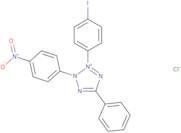
Product Information
- p-Iodonitrotetrazolium Violet
- INT
- 2-(4-Iodophenyl)-3-(4-nitrophenyl)-5-phenyl-2H-tetrazolium chloride
- 1-iodo-1-nitro-1H-tetrazol-1-ium chloride
- 2-(4-Iodophenyl)-3-(4-Nitrophenyl)-5-Phenyltetrazolium Chloride
- 2-(4-Iodophenyl)-3-(4-Nitrophrnyl)-5-Phenyl-2H-Tetrazoliu Chloride
- 2-(4-iodophenyl)-3-(4-nitrophenyl)-5-phenyl-2,3-dihydro-1H-tetrazole hydrochloride (1:1)
- 2-(p-Iodophenyl)-3-(p-nitrophenyl)-5-phenyltetrazolium chloride
- 2H-Tetrazolium, 2-(4-iodophenyl)-3-(4-nitrophenyl)-5-phenyl-, chloride
- 2H-Tetrazolium, 2-(4-iodophenyl)-3-(4-nitrophenyl)-5-phenyl-, chloride (1:1)
- See more synonyms
- 2H-Tetrazolium, 2-(p-iodophenyl)-3-(p-nitrophenyl)-5-phenyl-, chloride
- 3-(4-iodophenyl)-2-(4-nitrophenyl)-5-phenyl-2H-tetrazol-3-ium
- 3-(4-iodophenyl)-2-(4-nitrophenyl)-5-phenyl-2H-tetrazol-3-ium chloride
- 3-(P-Iodophenyl)-2-(P-Nitrophenyl)-5-Phenyl Tetrazolium Chloride
- 3-(p-Nitrophenyl)-2-(p-iodophenyl)-5-phenyltetrazolium chloride
- 4-Iodonitrotetrazolium Violet
- Int Chloride
- Iodonitro tetrazolium
- Iodonitrotetrazolium
- Iodonitrotetrazolium Chloride
- Iodonitrotetrazolium purple
- Iodonitrotetrazolium violet
- NSC 27620
- [2-(p-Iodophenyl)-3-(p-nitrophenyl)-5-phenyl-2H-tetrazolium chloride]
- p-Iodonitrotetrazolium violet
The monotetrazolium salt Iodonitrotetrazolium chloride (INT), first described by Atkinson et al. (1950), is an iodinated derivative of TTC (2,3,5-Triphenyltetrazolium chloride) with an absorption λmax of 248 nm. The color produced by reduction of this iodonitro compound is a red to purple or brownish formazan with an absorption maximum at 485 to 492 nm (depending on the solvent). INT is often used to visualize dehydrogenase activity histochemically as well as in Western blot staining and as a staining agent for agar colony formation assays. NAD or NADP-dependent dehydrogenases activity assays: NAD+- or NADP+-dependent dehydrogenase transfers electrons from a substrate (the electron donor, e.g. succinate) to NAD+ or NADP+, forming NADH and NADPH, respectively. Then, the final transfer of hydrogen to the tetrazolium salt is catalyzed by NADH or NADPH dehydrogenases (e.g. succinate dehydrogenase), leading to the reduction of INT and formation of the water-insoluble INT-formazan. 1 mol of formazan is produced for each mole of succinate utilized in the presence of INT. It is importan t to mention for applications in histology, that INT-formazan precipitates at the site of this latter dehydrogenase but not at the site of the original NAD+- or NADP+-dependent dehydrogenase activity.
Chemical properties
Technical inquiry about: 3D-I-7630 Iodonitrotetrazolium chloride
If you want to request a quotation or place an order, please instead add the desired products to your cart and then request a quotation or order from the cart. It is faster, cheaper, and you will be able to benefit from the available discounts and other advantages.





